Synergistic Effects of Steel Fibers and Silica Fume on Concrete Exposed to High Temperatures and Gamma Radiation
Abstract
1. Introduction
2. Materials and Methods
2.1. Materials
2.1.1. Cement
2.1.2. Aggregates
2.1.3. Fiber Steel
2.1.4. Silica Fume
2.2. Specimen Preparation
2.3. Mix Proportioning
2.4. Test Method
2.4.1. Radiation (Cobalt 60) Resistance
2.4.2. High Temperature Resistance
2.4.3. Ultrasonic Pulse Velocity Test
2.4.4. Flexural Strength Test
2.4.5. Compressive Strength Test
2.4.6. Microstructure Analysis
3. Experimental Outcomes and Discussion
3.1. Compressive Strength
3.2. Flexural Strength
3.3. Ultrasonic Pulse Velocity (UPV) Test
3.4. SEM-EDX Analysis
3.4.1. SEM Analysis
3.4.2. EDX Analysis
3.5. XRD Analysis
4. Conclusions and Recommendations
Funding
Data Availability Statement
Acknowledgments
Conflicts of Interest
References
- Al-Kheetan, M.J.; Al-Tarawneh, M.; Ghaffar, S.H.; Chougan, M.; Jweihan, Y.S.; Rahman, M.M. Resistance of Hydrophobic Concrete with Different Moisture Contents to Advanced Freeze–Thaw Cycles. Struct. Concr. 2021, 22, E1050–E1061. [Google Scholar] [CrossRef]
- Durmaz, M.; Doğruyol, M. Pistachio Shell Ash in Agro-Waste Cement Composites: A Pathway to Low-Carbon Binders. Sustainability 2025, 17, 4003. [Google Scholar] [CrossRef]
- Doğruyol, M.; Durmaz, M. The Effect of Pistachio Vera Shell Ash on Concrete Performance. Bitlis Eren Üniversitesi Fen Bilim. Derg. 2025, 14, 513–528. [Google Scholar] [CrossRef]
- Yu, Y.; Wang, W.; Shehu, R.; Pomaro, B. Editorial on Special Issue “Performance Prediction, Durability and Modelling of Concrete Materials and Structures”. Crystals 2022, 12, 1012. [Google Scholar] [CrossRef]
- Babu, S.S.; Specht, E.D.; David, S.A.; Karapetrova, E.; Zschack, P.; Peet, M.; Bhadeshia, H.K.D.H. In-Situ Observations of Lattice Parameter Fluctuations in Austenite and Transformation to Bainite. Metall. Mater. Trans. A Phys. Metall. Mater. Sci. 2005, 36, 3281–3289. [Google Scholar] [CrossRef]
- Plioplys, L. Development and Mechanical Performance Analysis of High-Temperature Resistant Concrete Composite. Ph.D. Thesis, Vilnius Gediminas Technical University, Vilnius, Lithuania, 2025. [Google Scholar]
- Afroughsabet, V.; Ozbakkaloglu, T. Mechanical and Durability Properties of High-Strength Concrete Containing Steel and Polypropylene Fibers. Constr. Build. Mater. 2015, 94, 73–82. [Google Scholar] [CrossRef]
- Bagherzadeh, R.; Sadeghi, A.H.; Latifi, M. Utilizing Polypropylene Fibers to Improve Physical and Mechanical Properties of Concrete. Text. Res. J. 2012, 82, 88–96. [Google Scholar] [CrossRef]
- Mastali, M.; Dalvand, A. Use of Silica Fume and Recycled Steel Fibers in Self-Compacting Concrete (SCC). Constr. Build. Mater. 2016, 125, 196–209. [Google Scholar] [CrossRef]
- Kathirvel, P.; Murali, G. Effect of Using Available GGBFS, Silica Fume, Quartz Powder and Steel Fibres on the Fracture Behavior of Sustainable Reactive Powder Concrete. Constr. Build. Mater. 2023, 375, 130997. [Google Scholar] [CrossRef]
- Liu, Y.; Shi, C.; Zhang, Z.; Li, N.; Shi, D. Mechanical and Fracture Properties of Ultra-High Performance Geopolymer Concrete: Effects of Steel Fiber and Silica Fume. Cem. Concr. Compos. 2020, 112, 103665. [Google Scholar] [CrossRef]
- Nkanpa Moffo, N.D.; Mwero, J.; Gariy, Z.A. Performance of Silica Fume on Preventing Strength Retrogression in Hardened Cement Paste and Mortar at Elevated Temperatures. Buildings 2023, 13, 1301. [Google Scholar] [CrossRef]
- Justnes, H. Silica Fume in High-Quality Concrete—A Review of Mechanism and Performance. Spec. Publ. 2007, 242, 63–78. [Google Scholar]
- Jahren, P.A. Fire Resistance of High Strength/Dense Concrete with Particular Reference to the Use of Condensed Silica Fume–A Review. Spec. Publ. 1989, 114, 1013–1050. [Google Scholar]
- Buhler, E.R. High Percentage Recovered Mineral Component (Silica Fume) in Extreme Concrete Exposure and Exceptional Concrete Durability Applications. In Proceedings of the Concrete Technology Forum, Dundee, UK, 20–22 May 2008; Focus on Sustainable Development National Ready Mixed Concrete Association: Alexandria, Egypt, 2008. [Google Scholar]
- He, X.X.; Wang, Q. Literature Review: Properties of Silica Fume Concrete. Adv. Mater. Res. 2014, 1004, 1516–1522. [Google Scholar] [CrossRef]
- Chmielewski, A.G. Radiation Technologies: The Future Is Today. Radiat. Phys. Chem. 2023, 213, 111233. [Google Scholar] [CrossRef]
- Jacobs, G.P. Validation of the Radiation Sterilization of Pharmaceuticals. In Handbook of Validation in Pharmaceutical Processes, 4th ed.; CRC Press: Boca Raton, FL, USA, 2021; pp. 355–373. [Google Scholar]
- Hlaváč, Z.; Zatloukalová, J.; Košťál, M.; Losa, E. Study of a Gamma Radiation Impact on Concrete Properties Under Severe Accident Conditions. J. Nucl. Eng. Radiat. Sci. 2021, 7, 22001. [Google Scholar] [CrossRef]
- Reches, Y. A Multi-Scale Review of the Effects of Gamma Radiation on Concrete. Results Mater. 2019, 2, 100039. [Google Scholar] [CrossRef]
- Fillmore, D.L. Literature Review of the Effects of Radiation and Temperature on the Aging of Concrete. 2004. Available online: https://digital.library.unt.edu/ark:/67531/metadc891149/ (accessed on 12 April 2025).
- Yan, X.L. Very High Temperature Reactor. In Handbook of Generation IV Nuclear Reactors: A Guidebook; Elsevier: Amsterdam, The Netherlands, 2023; pp. 133–165. ISBN 9780128205884. [Google Scholar]
- Bae, S. Temperature Effects in ACI 307, ACI 349, and ACI 359. ACI Struct. J. 2014, 111, 1135–1146. [Google Scholar] [CrossRef]
- ACI 318-11; Building Code Requirements for Structural Concrete, An ACI Standard and Commentary. American Concrete Institute: Farmington Hills, MI, USA, 2013.
- Tartaglia, R.; D’Aniello, M.; Wald, F. Behaviour of Seismically Damaged Extended Stiffened End-Plate Joints at Elevated Temperature. Eng. Struct. 2021, 247, 113193. [Google Scholar] [CrossRef]
- Schneider, U.; Alonso, M.C.; Pimienta, P.; Jansson, R. Physical Properties and Behaviour of High-Performance Concrete at High Temperatures. In Structures in Fire, Proceedings of the Sixth International Conference on SiF (SiF’10), East Lansing, MI, USA, 2–4 June 2010; Kodur, V., Franssen, J.-M., Eds.; Destech Pubns Inc: Lancaster, PA, USA, 2010; pp. 800–808. [Google Scholar]
- Mróz, K.; Tekieli, M.; Hager, I. Feasibility Study of Digital Image Correlation in Determining Strains in Concrete Exposed to Fire. Materials 2020, 13, 2516. [Google Scholar] [CrossRef]
- Liu, J.C.; Tan, K.H.; Yao, Y. A New Perspective on Nature of Fire-Induced Spalling in Concrete. Constr. Build. Mater. 2018, 184, 581–590. [Google Scholar] [CrossRef]
- Amran, M.; Huang, S.-S.; Onaizi, A.M.; Murali, G.; Abdelgader, H.S. Fire Spalling Behavior of High-Strength Concrete: A Critical Review. Constr. Build. Mater. 2022, 341, 127902. [Google Scholar] [CrossRef]
- Akbulut, Z.F.; Kuzielová, E.; Tawfik, T.A.; Smarzewski, P.; Guler, S. Synergistic Effects of Polypropylene Fibers and Silica Fume on Structural Lightweight Concrete: Analysis of Workability, Thermal Conductivity, and Strength Properties. Materials 2024, 17, 5042. [Google Scholar] [CrossRef]
- Abdullah, M.A.H.; Rashid, R.S.M.; Amran, M.; Hejazii, F.; Azreen, N.M.; Fediuk, R.; Voo, Y.L.; Vatin, N.I.; Idris, M.I. Recent Trends in Advanced Radiation Shielding Concrete for Construction of Facilities: Materials and Properties. Polymers 2022, 14, 2830. [Google Scholar] [CrossRef]
- Shill, S.K.; Al-Deen, S.; Ashraf, M.; Hutchison, W.; Hossain, M.M. Performance of Amine Cured Epoxy and Silica Fume Modified Cement Mortar Under Military Airbase Operating Conditions. Constr. Build. Mater. 2020, 232, 117280. [Google Scholar] [CrossRef]
- Hossain, M.M.; Al-Deen, S.; Hassan, M.K.; Shill, S.K.; Kader, M.A.; Hutchison, W. Mechanical and Thermal Properties of Hybrid Fibre-Reinforced Concrete Exposed to Recurrent High Temperature and Aviation Oil. Materials 2021, 14, 2725. [Google Scholar] [CrossRef]
- Shill, S.K.; Al-Deen, S.; Ashraf, M.; Rashed, M.G.; Hutchison, W. Consequences of Aircraft Operating Conditions at Military Airbases: Degradation of Ordinary Mortar and Resistance Mechanism of Acrylic and Silica Fume Modified Cement Mortar. Road Mater. Pavement Des. 2022, 23, 98–111. [Google Scholar] [CrossRef]
- Umeki, Y.; Sawada, S.; Mitsugi, S.; Maenaka, T.; Takiguchi, K. Outline of Guidelines for Maintenance and Management of Structures in Nuclear Facilities. J. Adv. Concr. Technol. 2016, 14, 643–663. [Google Scholar] [CrossRef]
- Medvedev, V.; Pustovgar, A. A Review of Concrete Carbonation and Approaches to Its Research under Irradiation. Buildings 2023, 13, 1998. [Google Scholar] [CrossRef]
- Medvedev, V.; Pustovgar, A.; Adamtsevich, A.; Adamtsevich, L. Concrete Carbonation of Deep Burial Storage Constructions under Model Aging Conditions. Buildings 2023, 14, 8. [Google Scholar] [CrossRef]
- Willam, K.; Xi, Y.; Naus, D.J. Concrete under High Temperature. In Infrastructure Systems for Nuclear Energy; John Wiley & Sons: Hoboken, NJ, USA, 2014; pp. 439–457. [Google Scholar] [CrossRef]
- Maruyama, I.; Haba, K.; Sato, O.; Ishikawa, S.; Kontani, O.; Takizawa, M. A Numerical Model for Concrete Strength Change under Neutron and Gamma-Ray Irradiation. J. Adv. Concr. Technol. 2016, 14, 144–163. [Google Scholar] [CrossRef]
- Maruyama, I.; Kontani, O.; Takizawa, M.; Sawada, S.; Ishikawa, S.; Yasukouchi, J.; Sato, O.; Etoh, J.; Igari, T. Development of Soundness Assessment Procedure for Concrete Members Affected by Neutron and Gamma-Ray Irradiation. J. Adv. Concr. Technol. 2017, 15, 440–523. [Google Scholar] [CrossRef]
- TS 10514; Concrete-Steel Fibre Reinforced-Rules for Mixing Concrete and Control. Turkish Standards Institute: Ankara, Turkey, 1992.
- ISO 834-1:1999; Fire Resistance Tests-Elements of Building Construction. International Organization for Standardization: Geneva, Switzerland, 1999.
- ASTM E119; Standard Test Methods for Fire Tests of Building Construction and Materials. ASTM International: West Conshohocken, PA, USA, 1987.
- ES 4756/1-2007; Composition, Specifications and Conformity Criteria for Common Cements, Part 1. Egyptian Organization for Standardization and Quality (EOS): Zeitoun, Egypt, 2007.
- ASTM C150-07; Standard Specification for Portland Cement. ASTM International: West Conshohocken, PA, USA, 2007.
- ASTM C204-25; Standard Test Methods for Fineness of Hydraulic Cement by Air-Permeability Apparatus. ASTM International: West Conshohocken, PA, USA, 2025.
- EN 196-6:2019; Methods of testing cement-Part 6: Determination of Fineness. The European Committee for Standardization: Bruxelles, Belgium, 2019.
- Torabi, S.A. Characterization of Forms of Silica with Varying Degrees of Crystallinity in Respirable Mine Dust. Master’s Thesis, The Pennsylvania State University, University Park, PA, USA, 2024. [Google Scholar]
- TS 802; Beton Karışım Tasarımı Hesap Esasları. Türk Standardları Enstitüsü: Ankara, Turkey, 2016.
- Zheng, S.; Liu, T.; Jiang, G.; Wen, D.; Dai, T.; Yang, G.; Gu, H.; Fang, C. Direct Evidence of Pore Structural Effects on the Compressive Strength of Lightweight Cement Slurry Containing Nano Silica Fume and Hollow Glass Microspheres. Constr. Build. Mater. 2024, 411, 134703. [Google Scholar] [CrossRef]
- Zheng, Y.; Xi, X.; Liu, H.; Du, C.; Lu, H. A Review: Enhanced Performance of Recycled Cement and CO2 Emission Reduction Effects Through Thermal Activation and Nanosilica Incorporation. Constr. Build. Mater. 2024, 422, 135763. [Google Scholar] [CrossRef]
- Ashraf, M.; Iqbal, M.F.; Rauf, M.; Ashraf, M.U.; Ulhaq, A.; Muhammad, H.; Liu, Q. feng Developing a Sustainable Concrete Incorporating Bentonite Clay and Silica Fume: Mechanical and Durability Performance. J. Clean. Prod. 2022, 337, 130315. [Google Scholar] [CrossRef]
- Hamada, H.M.; Abed, F.; Binti Katman, H.Y.; Humada, A.M.; Al Jawahery, M.S.; Majdi, A.; Yousif, S.T.; Thomas, B.S. Effect of Silica Fume on the Properties of Sustainable Cement Concrete. J. Mater. Res. Technol. 2023, 24, 8887–8908. [Google Scholar] [CrossRef]
- Bernard, E.; Dauzères, A.; Lothenbach, B. Magnesium and Calcium Silicate Hydrates, Part II: Mg-Exchange at the Interface “Low-PH” Cement and Magnesium Environment Studied in a C-S-H and M-S-H Model System. Appl. Geochem. 2018, 89, 210–218. [Google Scholar] [CrossRef]
- Bernard, E.; Jenni, A.; Fisch, M.; Grolimund, D.; Mäder, U. Micro-X-Ray Diffraction and Chemical Mapping of Aged Interfaces between Cement Pastes and Opalinus Clay. Appl. Geochem. 2020, 115, 104538. [Google Scholar] [CrossRef]
- Pernicova, R.; Citek, D.; Dobias, D.; Kolisko, J.; Mandlik, T.; Hausmannova, L. Development of a Low-PH Concrete Intended for Deep Geological Repository for Radioactive Waste. Buildings 2023, 13, 182. [Google Scholar] [CrossRef]
- Indukuri, C.S.R.; Nerella, R.; Madduru, S.R.C. Effect of Graphene Oxide on Microstructure and Strengthened Properties of Fly Ash and Silica Fume Based Cement Composites. Constr. Build. Mater. 2019, 229, 116863. [Google Scholar] [CrossRef]
- Dorairaj, D.; Govender, N.; Zakaria, S.; Wickneswari, R. Green Synthesis and Characterization of UKMRC-8 Rice Husk-Derived Mesoporous Silica Nanoparticle for Agricultural Application. Sci. Rep. 2022, 12, 20162. [Google Scholar] [CrossRef] [PubMed]
- Doğruyol, M. Characterization of Historic Mortars and the Effect of Rice Husk Ash (RHA) on Quicklime. Case Stud. Constr. Mater. 2024, 21, e03542. [Google Scholar] [CrossRef]
- 12390-12: 2020-04; Testing Hardened Concrete—Part 12: Determination of the Carbonation Resistance of Concrete—Accelerated Carbonation Method. Deutsches Institut Für Normung: Berlin, Germany, 2019.
- Saric-Coric, M.; Dénommé, Y.; Pagé, M.; Aïtcin, P.C. Performance of a New Co-Polymer Sulfonate-Based Mid-Range Water-Reducing Admixture. J. ASTM Int. 2005, 2, 1–23. [Google Scholar] [CrossRef]
- Li, X.; Ma, W. Optimization for Mix Design of High-Performance Concrete Using Orthogonal Test. In Proceedings of the Innovative Computing and Information: International Conference, ICCIC 2011, Wuhan, China, 17–18 September 2011; Part II. Springer: Berlin/Heidelberg, Germany, 2011; pp. 364–372. [Google Scholar]
- Seitl, S.; Benešová, A.; Pascual, Á.P.; Malíková, L.; Bujdoš, D.; Bílek, V. Fatigue and Fracture Properties of Concrete Mixtures with Various Water to Cement Ratio and Maximum Size of Aggregates. Procedia Struct. Integr. 2022, 42, 1512–1519. [Google Scholar] [CrossRef]
- ASTM C1240-20; Standard Specification for Silica Fume Used in Cementitious Mixtures. ASTM International: West Conshohocken, PA, USA, 2020.
- TS 1263-1; Fire Resistance Classes for Building Elements and Fire Resistance Test Methods. Türk Standartları Enstitüsü: Ankara, Turkey, 2015.
- Yönetmelik, B.Y.K.H. Resmî Gazete Sayı: 26735. 2007. Available online: https://www.resmigazete.gov.tr/eskiler/2007/12/20071219-2.htm (accessed on 12 April 2025).
- Pokorny, J.; Mozer, V.; Malerova, L.; Dlouha, D.; Wilkinson, P. A Simplified Method for Establishing Safe Available Evacuation Time Based on a Descending Smoke Layer. Komunikácie 2018, 20, 28–34. [Google Scholar] [CrossRef]
- Jevtic, R.B. Fire and Evacuation in High Residential Buildings. Facta Univ. Ser. Work. Living Environ. Prot. 2018, 15, 123–134. [Google Scholar] [CrossRef]
- ASTM C-597-02; Standard Test Method for Pulse Velocity through Concrete. ASTM International: West Conshohocken, PA, USA, 2002.
- TS EN 12504-4; Yapılarda Beton Deneyleri-Bölüm 4: Ultrasonik Atımlı Dalga Hızının Tayini. Standartları Enstitüsü: Ankara, Türkiye, 2012.
- TS. EN 12372; Natural Stone Test Methods-Determination of Flexural Strength Under Concentrated Load. Turkish Standard Institution: Ankara, Turkey, 2001.
- ASTM C39/C39M-14; Standard Test Method for Compressive Strength of Cylindrical Concrete Specimens. ASTM International: West Conshohocken, PA, USA, 2014.
- Durmaz, M. Investigation of Flexural, Compressive Strength and Microstructure of Silica Fume Added Steel Fiber Concrete. Avrupa Bilim ve Teknoloji Dergisi 2023, 52, 183–192. [Google Scholar]
- Madandoust, R.; Ranjbar, M.M.; Ghavidel, R.; Fatemeh Shahabi, S. Assessment of Factors Influencing Mechanical Properties of Steel Fiber Reinforced Self-Compacting Concrete. Mater. Des. 2015, 83, 284–294. [Google Scholar] [CrossRef]
- Dawood, E.T.; Ramli, M. Contribution of Hybrid Fibers on the Hybrid Fibers on the Properties of High Strength Concrete Having High Workability. Procedia Eng. 2011, 14, 814–820. [Google Scholar] [CrossRef]
- Martínez-Barrera, G.; Ureña-Nuñez, F.; Gencel, O.; Brostow, W. Mechanical Properties of Polypropylene-Fiber Reinforced Concrete after Gamma Irradiation. Compos. Part A Appl. Sci. Manuf. 2011, 42, 567–572. [Google Scholar] [CrossRef]
- Wang, L.; Tang, J.; Song, J.; Huang, Q.-A. Gamma Irradiation Effects on Resistance of Surface Micromachined Polycrystalline Silicon Beams in MEMS. In Proceedings of the 2011 IEEE 24th International Conference on Micro Electro Mechanical Systems, Cancun, Mexico, 23–27 January 2011; IEEE: Washington, DC, USA, 2011; pp. 445–448. [Google Scholar]
- Mobasher, N.; Bernal, S.A.; Kinoshita, H.; Sharrad, C.A.; Provis, J.L. Gamma Irradiation Resistance of an Early Age Slag-Blended Cement Matrix for Nuclear Waste Encapsulation. J. Mater. Res. 2015, 30, 1563–1571. [Google Scholar] [CrossRef]
- Raza, S.S.; Qureshi, L.A.; Ali, B.; Raza, A.; Khan, M.M.; Salahuddin, H. Mechanical Properties of Hybrid Steel–Glass Fiber-Reinforced Reactive Powder Concrete After Exposure to Elevated Temperatures. Arab. J. Sci. Eng. 2020, 45, 4285–4300. [Google Scholar] [CrossRef]
- Xie, J.; Zhang, Z.; Lu, Z.; Sun, M. Coupling Effects of Silica Fume and Steel-Fiber on the Compressive Behaviour of Recycled Aggregate Concrete after Exposure to Elevated Temperature. Constr. Build. Mater. 2018, 184, 752–764. [Google Scholar] [CrossRef]
- Basu, S.; Sasmal, S.; Kundu, T. Ultrasonic Wave Characteristics in Multiscale Cementitious Materials at Different Stages of Hydration. Ultrasonics 2024, 142, 107397. [Google Scholar] [CrossRef]
- Azreen, M.N.; Pauzi, I.M.; Nasharuddin, I.; Haniza, M.M.; Akasyah, J.; Karsono, A.D.; Lei, V.Y. Prediction of Concrete Compression Strength Using Ultrasonic Pulse Velocity. In AIP Conference Proceedings; Proceedings of the International Nuclear Science, Technology and Engineering Conference 2015 (iNuSTEC2015), Negeri Sembilan, Malaysia, 17–19 August 2015; AIP Publishing: New York, NY, USA, 2016; Volume 1704. [Google Scholar]
- Turgut, P.; Kucuk, O.F. Comparative Relationships of Direct, Indirect, and Semi-Direct Ultrasonic Pulse Velocity Measurements in Concrete. Russ. J. Nondestruct. Test. 2006, 42, 745–751. [Google Scholar] [CrossRef]
- Miturski, M.; Sas, W.; Radzevičius, A.; Šadzevičius, R.; Skominas, R.; Stelmaszczyk, M.; Głuchowski, A. Effect of Dispersed Reinforcement on Ultrasonic Pulse Velocity in Stabilized Soil. Materials 2021, 14, 6951. [Google Scholar] [CrossRef]
- Viana, A.C.C.; de Moraes, P.D.; Padaratz, I.J. Ultrasonic Wave Propagation in Thermally Treated Concrete up to 400 °C. Rev. IBRACON Estrut. E Mater. 2022, 15, e15303. [Google Scholar] [CrossRef]
- IS 13311-1 (1992); Non-Destructive Testing of Concrete–Methods of Test, Part 1: Ultrasonic pulse velocity. Bureau of Indian Standards: New Delhi, India, 1992.
- Rasouli, M.; Naghib, S.M. Mechanism of Inhibition of Hydroxyapatite Nanoparticles on Cancer Cells and Recent Advances in the Field. Curr. Mech. Adv. Mater. 2021, 1, e271021194957. [Google Scholar] [CrossRef]
- Al-Tersawy, S.H.; El-Sadany, R.A.; Sallam, H.E.M. Long-Term Behavior of Normal Weight Concrete Containing Hybrid Nanoparticles Subjected to Gamma Radiation. Arch. Civ. Mech. Eng. 2021, 21, 9. [Google Scholar] [CrossRef]
- Kim, W.; Choi, H.; Lee, T. Residual Compressive Strength Prediction Model for Concrete Subject to High Temperatures Using Ultrasonic Pulse Velocity. Materials 2023, 16, 515. [Google Scholar] [CrossRef]
- Xie, J.; Huang, L.; Guo, Y.; Li, Z.; Fang, C.; Li, L.; Wang, J. Experimental Study on the Compressive and Flexural Behaviour of Recycled Aggregate Concrete Modified with Silica Fume and Fibres. Constr. Build. Mater. 2018, 178, 612–623. [Google Scholar] [CrossRef]
- Pomaro, B.; Xotta, G.; Salomoni, V.A.; Majorana, C.E. A Thermo-Hydro-Mechanical Numerical Model for Plain Irradiated Concrete in Nuclear Shielding. Mater. Struct./Mater. Constr. 2022, 55, 14. [Google Scholar] [CrossRef]
- De León-Condés, C.A.; Roa-Morales, G.; Martínez-Barrera, G.; Menchaca-Campos, C.; Bilyeu, B.; Balderas-Hernández, P.; Ureña-Núñez, F.; Toledo-Jaldin, H.P. Sulfonated and Gamma-Irradiated Waste Expanded Polystyrene with Iron Oxide Nanoparticles, for Removal of Indigo Carmine Dye in Textile Wastewater. Heliyon 2019, 5, e02071. [Google Scholar] [CrossRef] [PubMed]
- Martnez-Barrera, G.; Menchaca, C.; Urea-Nuez, F. Gamma Radiation as a Novel Technology for Development of New Generation Concrete. In Gamma Radiation; IntechOpen: Rijeka, Croatia, 2012; pp. 91–114. [Google Scholar] [CrossRef]
- Tiwari, S.S.; Holbert, K. Effect of Gamma-Rays on Morphology and Tensile Properties of Polypropylene Fiber for Cement Composites. Master’s Thesis, Arizona State University, Tempe, AZ, USA, 2018. [Google Scholar]
- Aqel, M.; Panesar, D.K. Delayed Ettringite Formation in Concrete Containing Limestone Filler. ACI Mater. J. 2018, 115, 565–574. [Google Scholar] [CrossRef]
- Wang, C.; Jin, Z.; Pang, B.; Li, J.; Dong, W.; Chen, R. Experimental Study of Delayed Ettringite Formation Under Geothermal High-Temperature Environment. J. Build. Eng. 2023, 78, 107519. [Google Scholar] [CrossRef]
- Castellote, M.; Alonso, C.; Andrade, C.; Turrillas, X.; Campo, J. Composition and Microstructural Changes of Cement Pastes upon Heating, as Studied by Neutron Diffraction. Cem. Concr. Res. 2004, 34, 1633–1644. [Google Scholar] [CrossRef]
- Alonso, C.; Fernandez, L. Dehydration and Rehydration Processes of Cement Paste Exposed to High Temperature Environments. J. Mater. Sci. 2004, 39, 3015–3024. [Google Scholar] [CrossRef]
- Martínez-López, M.; Martínez-Barrera, G.; Martínez-Martínez, J.E. Gamma Rays as Modifiers of the Compressive and Flexural Properties of Polyester Polymer Concrete. J. Mater. Civ. Eng. 2023, 35, 4023133. [Google Scholar] [CrossRef]
- Homam, S.M.; Sheikh, S.A. Fibre Reinforced Polymers (Frp) Manufactured for Civil Engineering Applications and Exposed To Gamma Radiation and Loss of Coolant Accident (Loca). 2005. Available online: http://individual.utoronto.ca/homam/scientific/Homam_LOCA_GAMMA.pdf (accessed on 12 April 2025).
- Danfour, A.; Perko, J.; Seetharam, S.; Phung, Q.T.; Jacques, D.; Cizer, Ö. Numerical Study of Potential Delayed Ettringite Formation in Cemented Nuclear Wasteforms. Sustainability 2024, 16, 389. [Google Scholar] [CrossRef]
- Godart, B. Pathology, Assessment and Treatment of Structures Affected by Delayed Ettringite Formation. Struct. Eng. Int. 2017, 27, 362–369. [Google Scholar] [CrossRef]
- Nguyen, V.H.; Leklou, N.; Mounanga, P. The Development of Accelerated Test Method for Internal Sulfate Attack by Delayed Ettringite Formation. Mater. Sci. Forum 2020, 987, 27–32. [Google Scholar] [CrossRef]
- Thomas, M.; Folliard, K.; Drimalas, T.; Ramlochan, T. Diagnosing Delayed Ettringite Formation in Concrete Structures. Cem. Concr. Res. 2008, 38, 841–847. [Google Scholar] [CrossRef]
- Mehta, P.K. Mechanism of Expansion Associated with Ettringite Formation. Cem. Concr. Res. 1973, 3, 1–6. [Google Scholar] [CrossRef]
- Kharchenco, I.; Alekseev, V. Effect of Ettringite Morphology on the Properties of Expanding Cement Systems. In Proceedings of the E3S Web of Conferences, Jember, Indonesia, 31 July–2 August 2019; EDP Sciences: Les Ulis, France, 2019; Volume 110, p. 1037. [Google Scholar]
- Kunther, W.; Lothenbach, B.; Skibsted, J. Influence of the Ca/Si Ratio of the C-S-H Phase on the Interaction with Sulfate Ions and Its Impact on the Ettringite Crystallization Pressure. Cem. Concr. Res. 2015, 69, 37–49. [Google Scholar] [CrossRef]
- Fan, C.; Wang, B.; Xu, Y. Solidification/Stabilization and Immobilization Mechanism of Pb(II) and Zn(II) in Ettringite. Cem. Concr. Res. 2023, 174, 107350. [Google Scholar] [CrossRef]
- Doğruyol, M. Determination of ASR in Concrete Using Characterization Methods. Buildings 2024, 14, 657. [Google Scholar] [CrossRef]
- Karasin, A.; Hadzima-Nyarko, M.; Işık, E.; Doğruyol, M.; Karasin, I.B.; Czarnecki, S. The Effect of Basalt Aggregates and Mineral Admixtures on the Mechanical Properties of Concrete Exposed to Sulphate Attacks. Materials 2022, 15, 1581. [Google Scholar] [CrossRef]
- García-Giménez, R.; Frias, M.; de la Villa, R.V.; Martínez-Ramírez, S. Ca/Si and Si/Al Ratios of Metakaolinite-Basedwastes: Their Influence on Mineralogy and Mechanical Strengths. Appl. Sci. 2018, 8, 480. [Google Scholar] [CrossRef]
- Gholizadeh-Vayghan, A.; Bellinkx, A.; Snellings, R.; Vandoren, B.; Quaghebeur, M. The Effects of Carbonation Conditions on the Physical and Microstructural Properties of Recycled Concrete Coarse Aggregates. Constr. Build. Mater. 2020, 257, 119486. [Google Scholar] [CrossRef]
- Šavija, B.; Luković, M. Carbonation of Cement Paste: Understanding, Challenges, and Opportunities. Constr. Build. Mater. 2016, 117, 285–301. [Google Scholar] [CrossRef]
- Glinicki, M.A.; Dąbrowski, M.; Antolik, A.; Dziedzic, K.; Sikorin, S.; Fateev, V.; Povolansky, E. Gamma Irradiation Sensitivity of Early Hardening Cement Mortar. Cem. Concr. Compos. 2022, 126, 104327. [Google Scholar] [CrossRef]
- Doğruyol, M.; Ayhan, E.; Karaşin, A. Effect of Waste Steel Fiber Use on Concrete Behavior at High Temperature. Case Stud. Constr. Mater. 2024, 20, e03051. [Google Scholar] [CrossRef]
- Soo, P.; Milian, L.M. The Effect of Gamma Radiation on the Strength of Portland Cement Mortars. J. Mater. Sci. Lett. 2001, 20, 1345–1348. [Google Scholar] [CrossRef]
- Vodák, F.; Vydra, V.; Trtík, K.; Kapičková, O. Effect of Gamma Irradiation on Properties of Hardened Cement Paste. Mater. Struct./Mater. Constr. 2011, 44, 101–107. [Google Scholar] [CrossRef]
- Aljawad, M.S.; Desouky, M.; Sølling, T.I.; Amao, A.O.; Al-Ramadan, K. Improving Carbonate Rock Hardness by Consolidating Additives to Sustain Long Term Fracture Conductivity. J. Pet. Sci. Eng. 2020, 195, 107897. [Google Scholar] [CrossRef]
- Pearce, J.K.; Dawson, G.K.W. Experimental Determination of Impure CO2 Alteration of Calcite Cemented Cap-Rock, and Long Term Predictions of Cap-Rock Reactivity. Geosciences 2018, 8, 241. [Google Scholar] [CrossRef]
- Kang, S.-M.; Moon, K.-K.; Lee, W.-G.; Song, M.-S. CO2 Diffusion and Carbonation in OPC/γ-2CaO· SiO2 Composite. Appl. Sci. 2023, 13, 4529. [Google Scholar]
- Hamoudi, A.; Khouchaf, L.; Depecker, C.; Revel, B.; Montagne, L.; Cordier, P. Microstructural Evolution of Amorphous Silica Following Alkali-Silica Reaction. J. Non-Cryst. Solids 2008, 354, 5074–5078. [Google Scholar] [CrossRef]
- Sabapathy, L.; Mohammed, B.S.; Al-Fakih, A.; Wahab, M.M.A.; Liew, M.S.; Amran, Y.H.M. Acid and Sulphate Attacks on a Rubberized Engineered Cementitious Composite Containing Graphene Oxide. Materials 2020, 13, 3125. [Google Scholar] [CrossRef]
- Doğruyol, M.; Karaşin, H. Sülfatın Beton ve Betonarme Elemanlara Olumsuz Etkisi. Dicle Üniversitesi Mühendislik Fakültesi Mühendislik Derg. 2011, 2, 79–85. [Google Scholar]
- Bizzozero, J. Hydration and Dimensional Stability of Calcium Aluminate Cement Based Systems. Ph.D. Thesis, École Polytechnique Fédérale de Lausanne, Lausanne, Switzerland, 2014. [Google Scholar]
- Weise, K.; Ukrainczyk, N.; Koenders, E. Pozzolanic Reactions of Metakaolin with Calcium Hydroxide: Review on Hydrate Phase Formations and Effect of Alkali Hydroxides, Carbonates and Sulfates. Mater. Des. 2023, 231, 112062. [Google Scholar] [CrossRef]
- Vollpracht, A.; Lothenbach, B.; Snellings, R.; Haufe, J. The Pore Solution of Blended Cements: A Review. Mater. Struct./Mater. et Constr. 2016, 49, 3341–3367. [Google Scholar] [CrossRef]
- Maruyama, I.; Ishikawa, S.; Yasukouchi, J.; Sawada, S.; Kurihara, R.; Takizawa, M.; Kontani, O. Impact of Gamma-Ray Irradiation on Hardened White Portland Cement Pastes Exposed to Atmosphere. Cem. Concr. Res. 2018, 108, 59–71. [Google Scholar] [CrossRef]
- Wu, B.; Ye, G. Development of Porosity of Cement Paste Blended with Supplementary Cementitious Materials After Carbonation. Constr. Build. Mater. 2017, 145, 52–61. [Google Scholar] [CrossRef]
- De Weerdt, K.; Justnes, H. The Effect of Sea Water on the Phase Assemblage of Hydrated Cement Paste. Cem. Concr. Compos. 2015, 55, 215–222. [Google Scholar] [CrossRef]
- Wu, S.; Liu, Q.; Li, L.; Kang, W.; Tiong, M.; Huang, T. Quantitative Characterization of Recycled Cementitious Materials Before and after Carbonation Curing: Carbonation Kinetics, Phase Assemblage, and Microstructure. Constr. Build. Mater. 2024, 421, 135596. [Google Scholar] [CrossRef]
- McCaurEyl, J.; Roy, R. Gontrolled Nucleation and Crystal Growth of Various CaCOu Phases by the Silica Gel Technique. Am. Mineral. 1974, 59, 947–963. [Google Scholar]
- Jóźwiak-Niedźwiedzka, D.; Dąbrowski, M.; Dziedzic, K.; Jarząbek, D.; Antolik, A.; Denis, P.; Glinicki, M.A. Effect of Gamma Irradiation on the Mechanical Properties of Carbonation Reaction Products in Mortar. Mater. Struct./Mater. Et Constr. 2022, 55, 164. [Google Scholar] [CrossRef]
- Vodák, F.; Trtík, K.; Sopko, V.; Kapičková, O.; Demo, P. Effect of γ-Irradiation on Strength of Concrete for Nuclear-Safety Structures. Cem. Concr. Res. 2005, 35, 1447–1451. [Google Scholar] [CrossRef]
- Auroy, M.; Poyet, S.; Le Bescop, P.; Torrenti, J.M. Impact of Carbonation on the Durability of Cementitious Materials: Water Transport Properties Characterization. In Proceedings of the EPJ Web of Conferences, Varenna, Italy, 30 July–4 August 2012; EDP Sciences: Les Ulis, France, 2013; Volume 56, p. 1008. [Google Scholar]
- Venkat Rao, N.; Meena, T. A Review on Carbonation Study in Concrete. In Proceedings of the Materials Science and Engineering Conference Series, Busan, Korea, 25–27 August 2017; Volume 263, p. 32011. [Google Scholar]
- Wadile, M.; Joshi, H.; Pawar, R. A Review on Experimental Study to Reduce Carbonation Effect on Concrete. Int. J. Res. Appl. Sci. Eng. Technol. 2023, 11, 591–594. [Google Scholar] [CrossRef]
- Li, H.; Shui, Z.; Wang, Z.; Xiao, X. Effects of UV Radiation on the Carbonation of Cement-Based Materials with Supplementary Cementitious Materials. Coatings 2023, 13, 994. [Google Scholar] [CrossRef]
- Wang, T.; Medepalli, S.; Zheng, Y.; Zhang, W.; Ishida, T.; Bishnoi, S.; Hou, D.; Shi, Z. Retardation Effect of the Pozzolanic Reaction of Low-Calcium Supplementary Cementitious Materials on Clinker Hydration at Later Age: Effects of Pore Solution, Foreign Ions, and PH. Cem. Concr. Res. 2024, 177, 107416. [Google Scholar] [CrossRef]
- Evarestov, R.A. Space Groups and Crystalline Structures. In Quantum Chemistry of Solids: The LCAO First Principles Treatment of Crystals; Springer: Berlin/Heidelberg, Germany, 2007; pp. 7–46. [Google Scholar]
- Islam, M.S.; Morikawa, D.; Yamada, S.; Aryal, B.; Tsuda, K.; Terauchi, M. Space Group Determination and First-Principles Structure Optimization of the A-Site Ordered Perovskite-Type Manganite NdBaMn 2 O 6. Phys. Rev. B 2022, 105, 174114. [Google Scholar] [CrossRef]
- Aoyei, A.K.; Birman, J.L. A New Group-Theoretical Approach to Cell-Preserving Phase Transitions in Crystals. Phys. Status Solidi (B) 1977, 82, 565–575. [Google Scholar] [CrossRef]
- Lord, E.A.; Banaru, A.M. Number of Generating Elements in Space Group of a Crystal. Mosc. Univ. Chem. Bull. 2012, 67, 50–58. [Google Scholar] [CrossRef]
- Omarov, R.; Belov, V.; Morozenko, A. Studying Radiation-Induced Degradation of Reinforced Concrete Structures: Review and Numerical Analysis of Reinforcement Corrosion Processes in Concrete. Appl. Sci. 2024, 14, 11856. [Google Scholar] [CrossRef]
- Doğruyol, M. Characterisation of Acrylic Copolymer Treated Concretes and Concretes of Reinforced Concrete Buildings Collapsed in the 6 February 2023 Mw = 7.8 Kahramanmaraş (Türkiye) Earthquake. Eng. Fail. Anal. 2024, 161, 108249. [Google Scholar] [CrossRef]
- Kodur, V.K.R.; McGrath, R. Effect of Silica Fume and Lateral Confinement on Fire Endurance of High Strength Concrete Columns. Can. J. Civ. Eng. 2006, 33, 93–102. [Google Scholar] [CrossRef]
- Pignatelli, I.; Kumar, A.; Field, K.G.; Wang, B.; Yu, Y.; Le Pape, Y.; Bauchy, M.; Sant, G. Direct Experimental Evidence for Differing Reactivity Alterations of Minerals Following Irradiation: The Case of Calcite and Quartz. Sci. Rep. 2016, 6, 20155. [Google Scholar] [CrossRef]
- Łowińska-Kluge, A.; Piszora, P. Effect of Gamma Irradiation on Cement Composites Observed with XRD and SEM Methods in the Range of Radiation Dose 0-1409 MGy. Acta Phys. Pol. A 2008, 114, 399–411. [Google Scholar] [CrossRef]
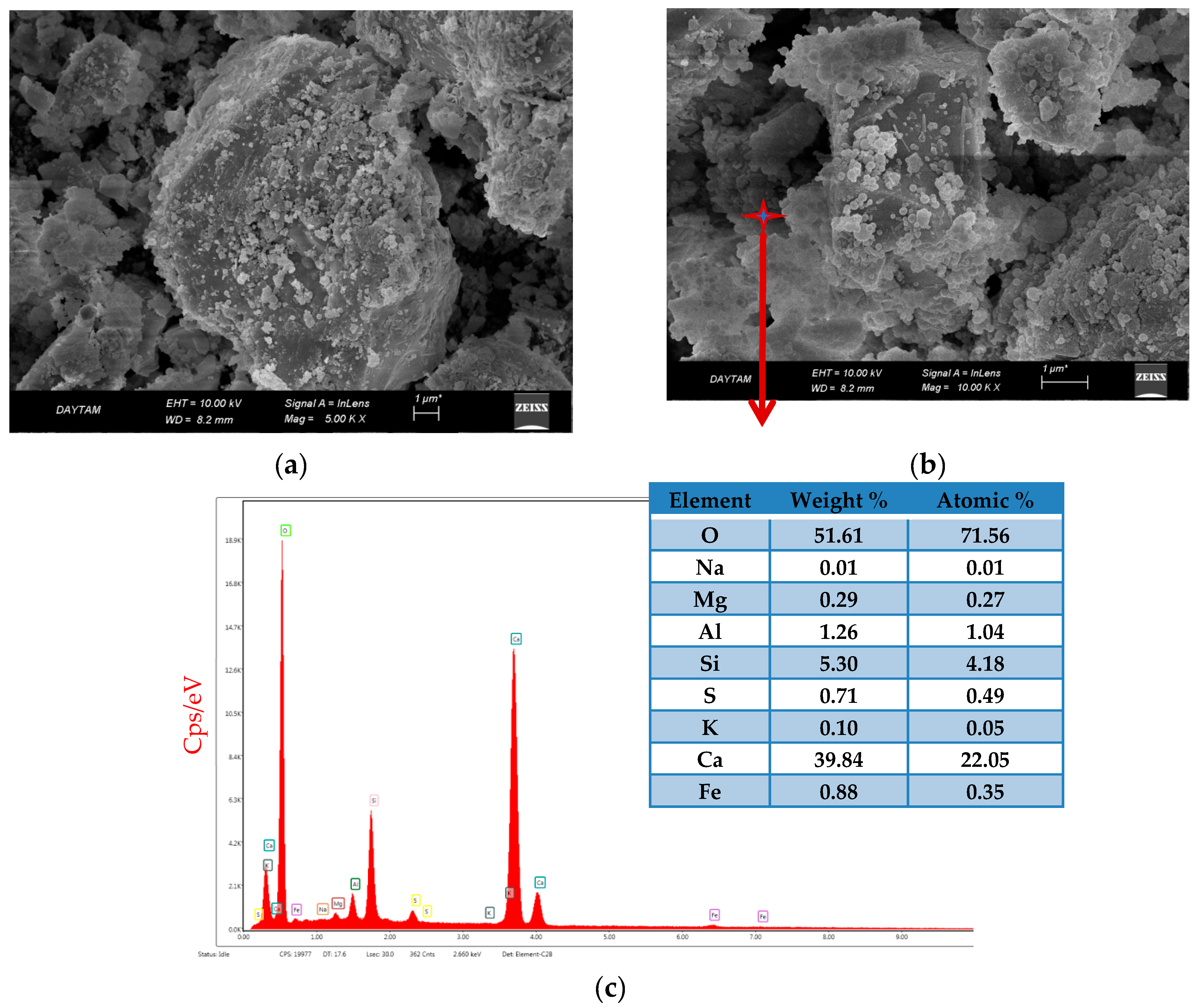

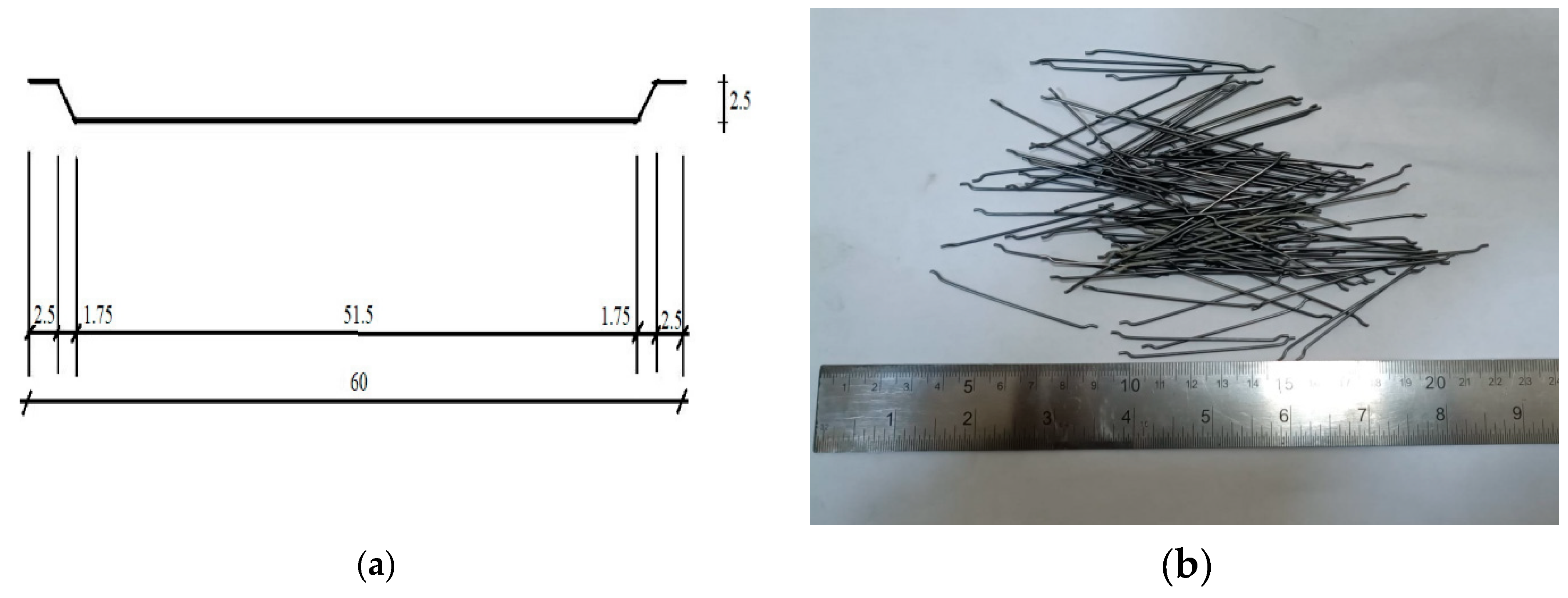
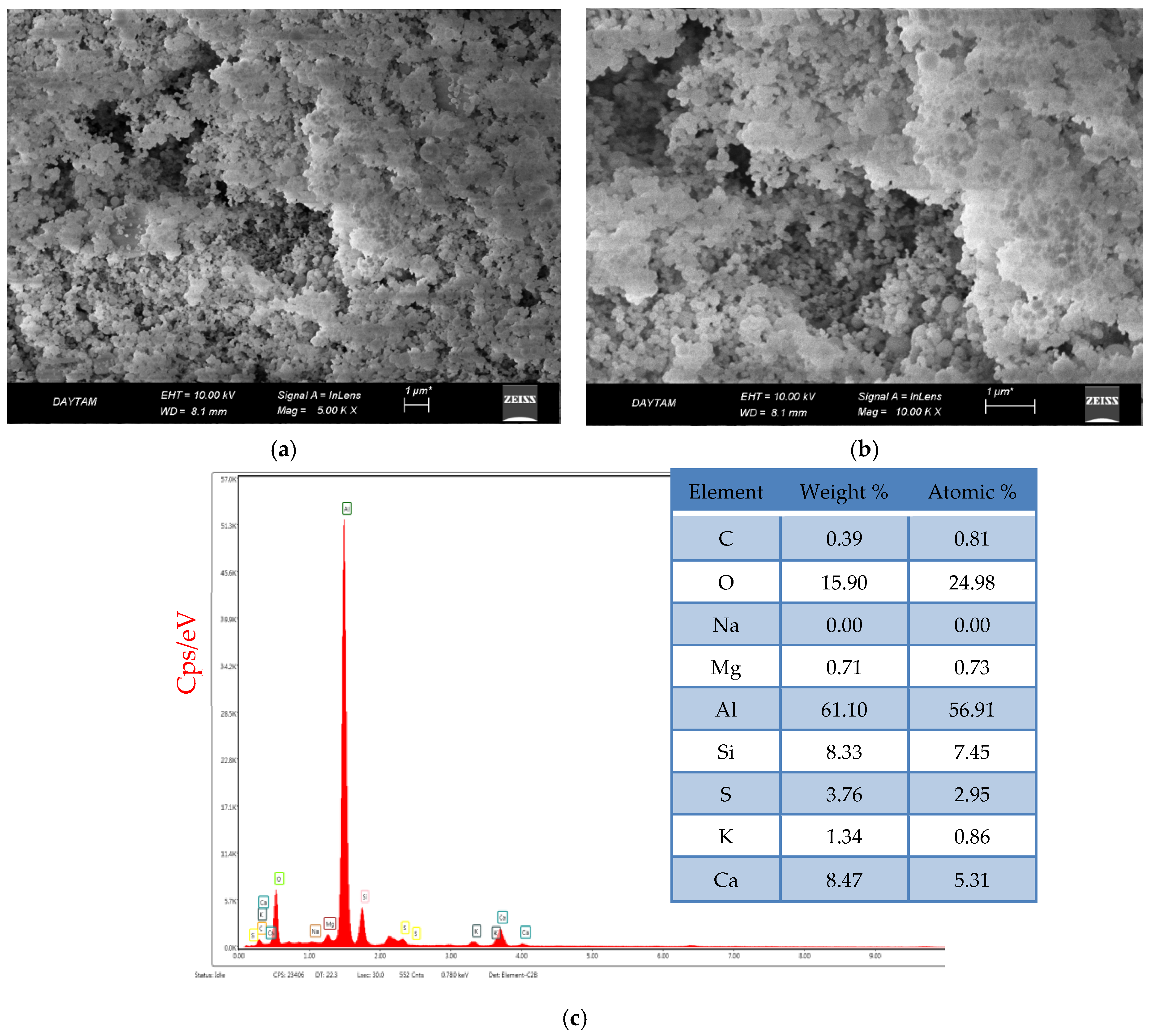
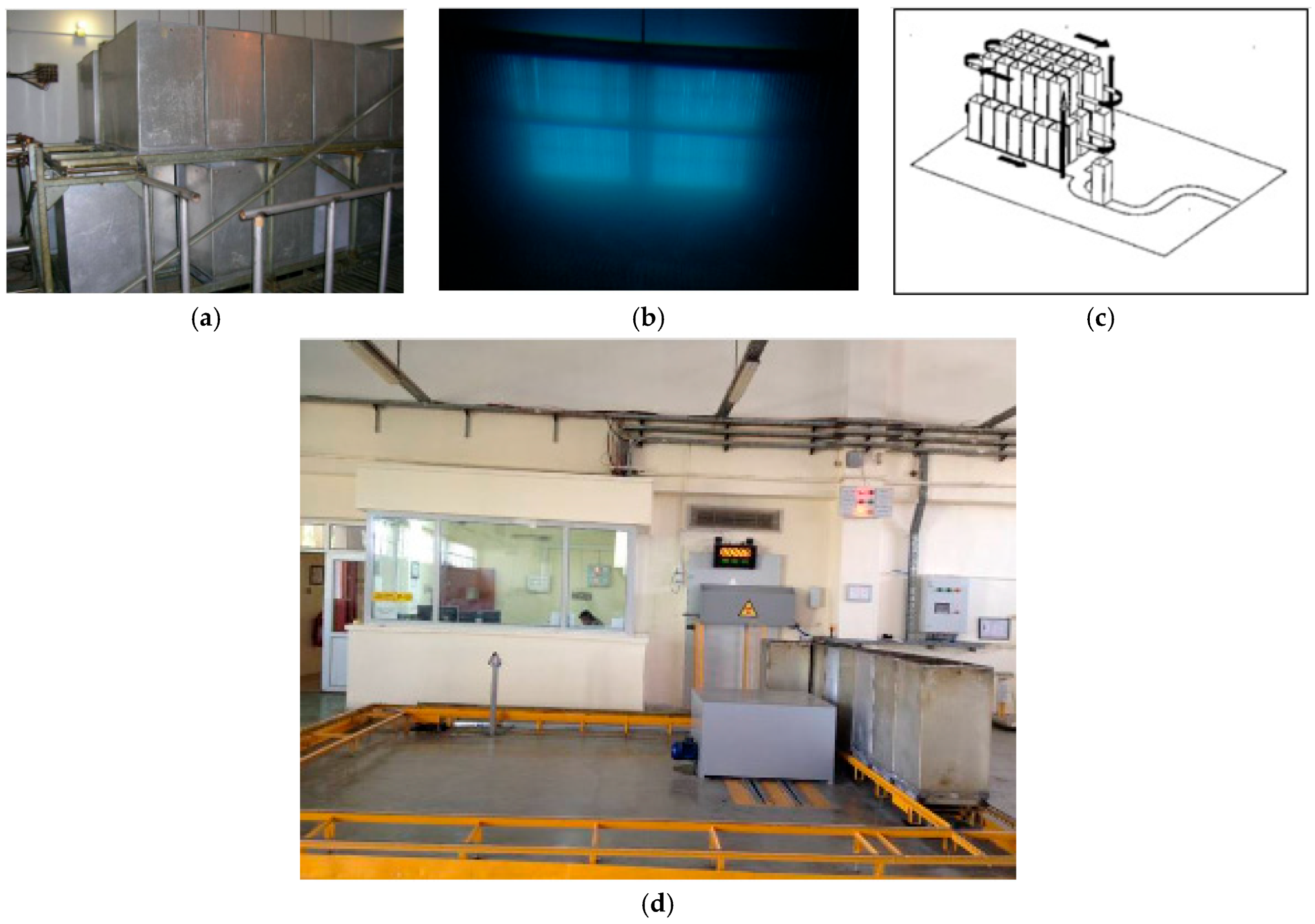
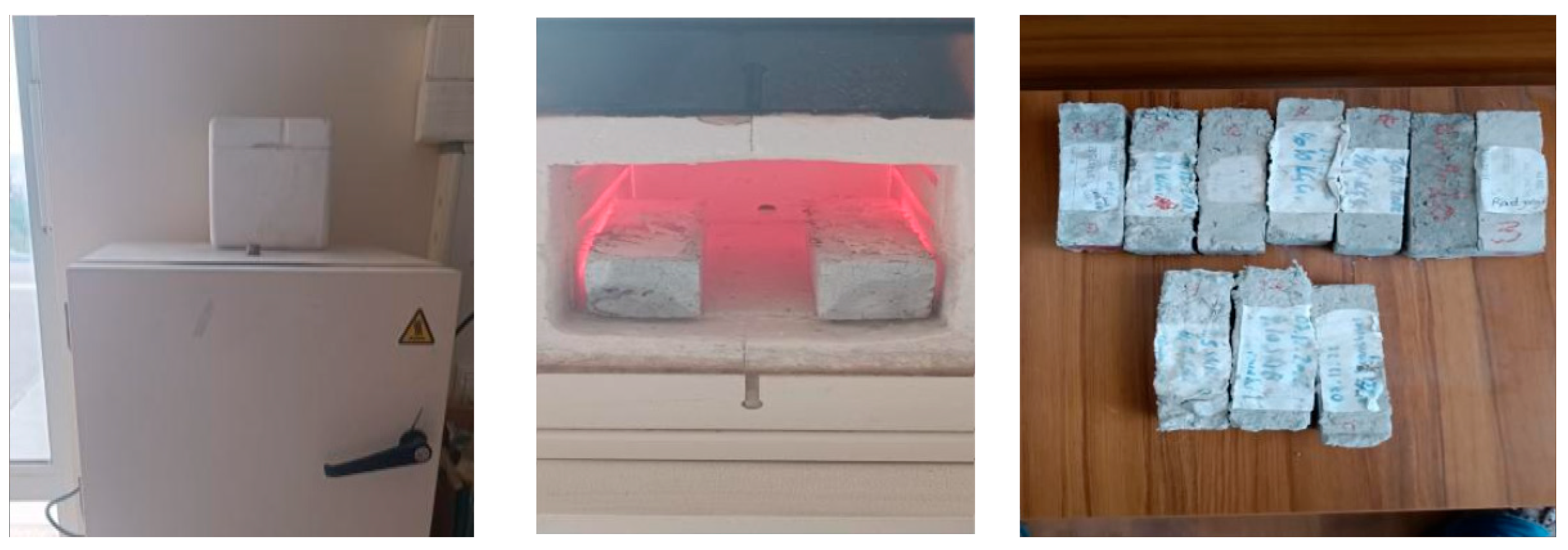
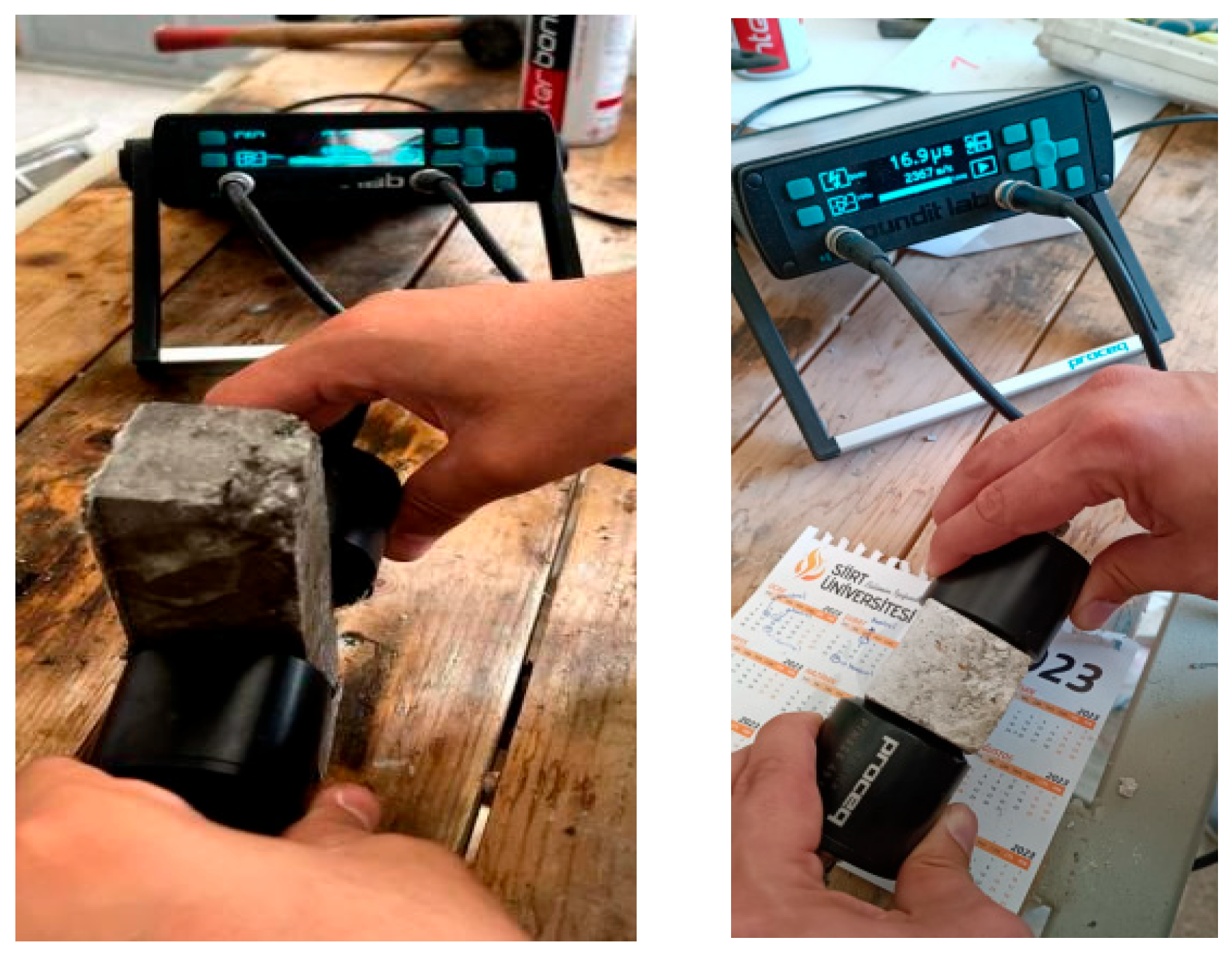

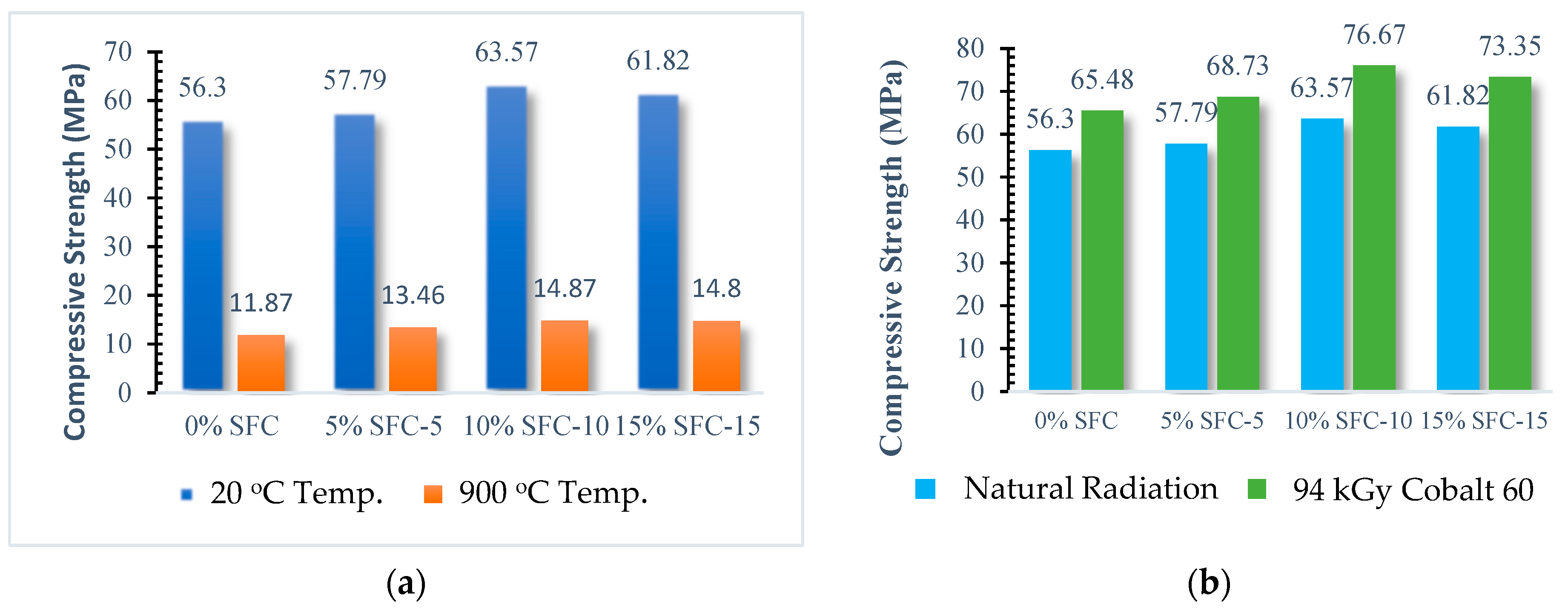


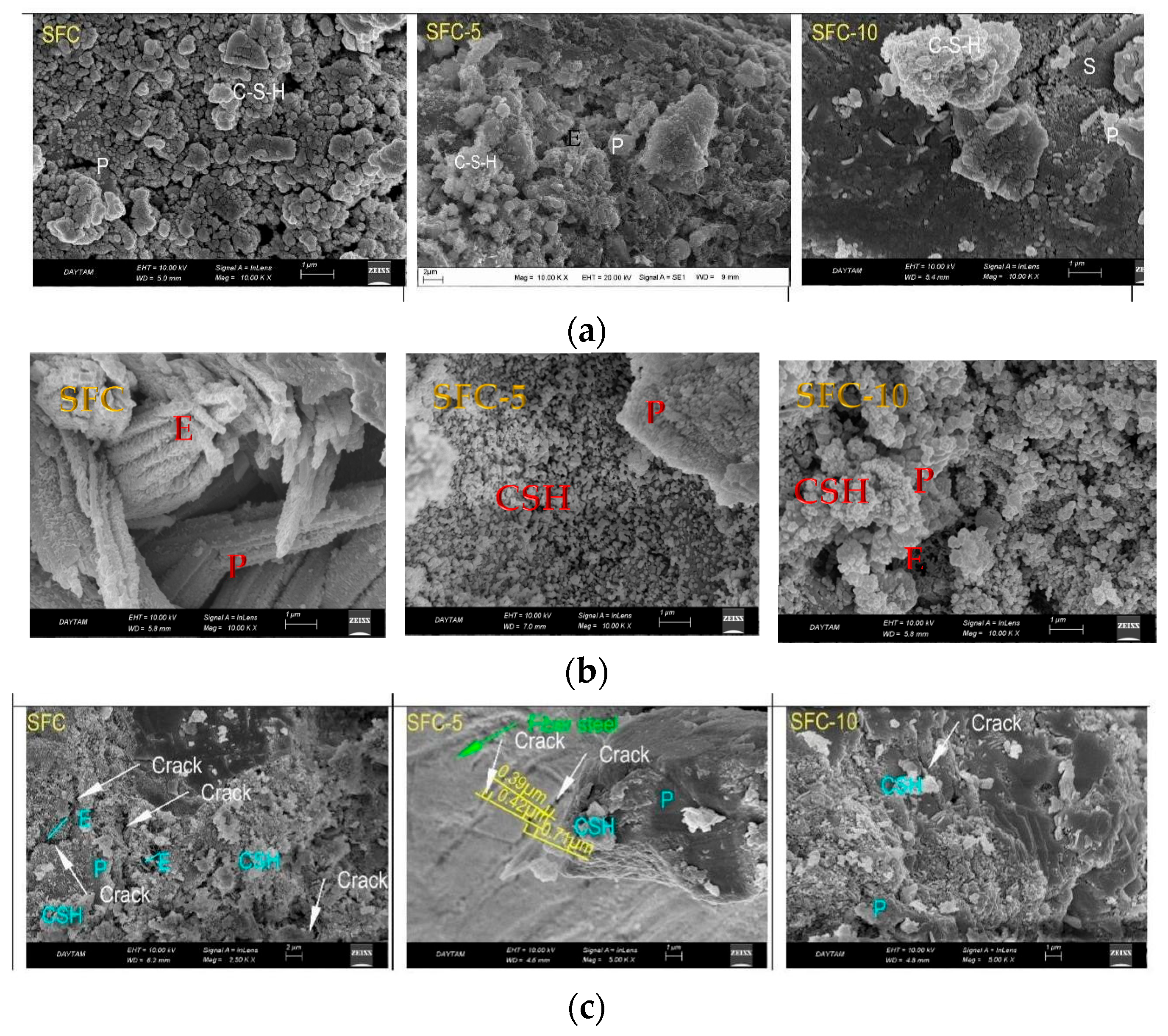
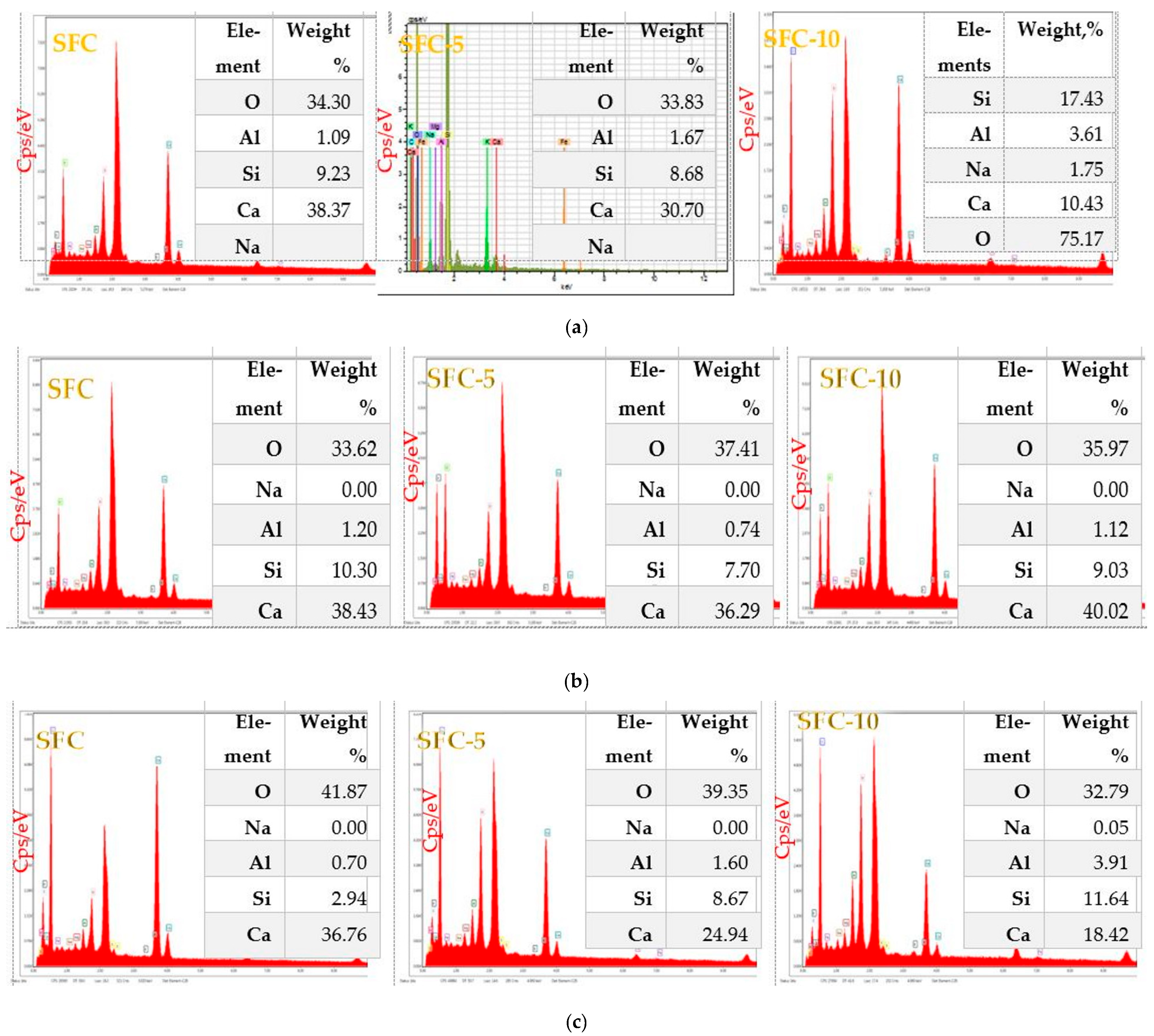
 ) Portlandite, (
) Portlandite, ( ) quartz, (
) quartz, ( ) calcite, (
) calcite, ( ) ettringite.
) ettringite.
 ) Portlandite, (
) Portlandite, ( ) quartz, (
) quartz, ( ) calcite, (
) calcite, ( ) ettringite.
) ettringite.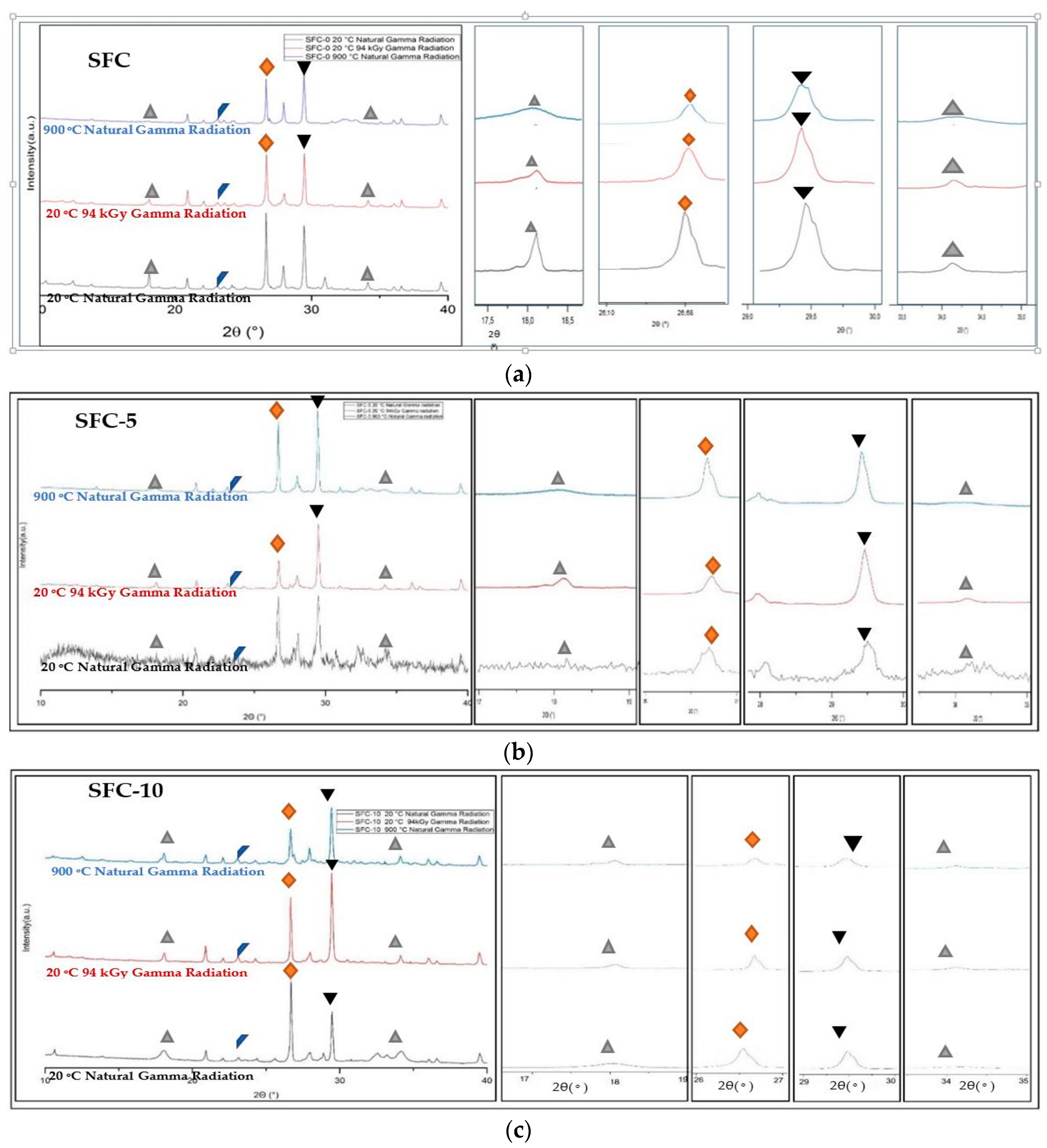
| Component | Cement % | Silica Fume % |
|---|---|---|
| SiO2 | 20.63 | 94 |
| Fe2O3 | 3.41 | 0.7 |
| AI2O3 | 4.71 | 1.2 |
| CaO | 63.64 | 0.8 |
| SO3 | 2.98 | |
| CI− | 0.04 | |
| Glow Loss | 1.25 | 0.7 |
| K2O | 0.91 | 0.9 |
| Na2O | 0.23 | 0.3 |
| Free lime CaO | 1.1 |
| S/No | Physical Properties | Fine Aggregate | Coarse Aggregate 12.5 mm |
|---|---|---|---|
| 1 | Percent of particles retained on the 4.75 mm sieve | 1 | 96 |
| 2 | Percent of particles passing the 4.75 mm sieve | 98 | 4 |
| 3 | Percent of particles passing the 0.075 mm sieve | 2.8 | 0 |
| 4 | Fineness modulus | 2.73 | 2.68 |
| 5 | Coefficient of uniformity (Cu) | 3.70 | 1.97 |
| 6 | Coefficient of curvature (Cc) | 1.12 | 0.89 |
| 7 | Bulk density | 1653 | 1652 |
| 8 | Specific gravity | 2.62 | 2.69 |
| 9 | Moisture (water) absorption (%) | 1.39 | 0.44 |
| 10 | Aggregate crushing value (%) | - | 19 |
| 11 | Aggregate impact value (%) | - | 14 |
| Material | Mix Proportions | ||||
|---|---|---|---|---|---|
| PLC | SFC | SFC-5 | SFC-10 | SFC-15 | |
| Portland Cement | 420 | 420 | 399 | 378 | 357 |
| Silica Fume | 0 | 0 | 21 | 42 | 63 |
| Water | 189 | 189 | 189 | 189 | 189 |
| Steel Fiber | 0 | 50 | 50 | 50 | 50 |
| Fine Aggregate (0–6 mm) | 1200 | 1200 | 1200 | 1200 | 1200 |
| Coarse Aggregate (6–12.5 mm) | 600 | 600 | 600 | 600 | 600 |
| Superplasticizer | 4 | 4 | 4 | 4 | 4 |
| Total | 2413 | 2463 | 2463 | 2463 | 2463 |
| DAY 28 | ||||||
|---|---|---|---|---|---|---|
| 20 °C Natural Radiation | 20 °C 94 kGy Radiation | 900 °C Natural Radiation | ||||
| Measured | σ 1 | Measured | σ 1 | Measured | σ 1 | |
| (MPa) | (MPa) | (MPa) | ||||
| SFC | 56.3 | 1.21 | 65.48 | 1.08 | 11.87 | 1.26 |
| SFC-5 | 57.79 | 1.27 | 68.73 | 1.14 | 13.46 | 1.30 |
| SFC-10 | 63.57 | 1.23 | 76.67 | 1.21 | 14.87 | 1.27 |
| SFC-15 | 61.82 | 1.37 | 73.35 | 1.34 | 14.80 | 1.39 |
| DAY 28 | ||||||
|---|---|---|---|---|---|---|
| 20 °C Natural Radiation | 20 °C 94 kGy Gamma Radiation | 900 °C Natural Radiation | ||||
| Measured | σ 1 | Measured | σ 1 | Measured | σ 1 | |
| (MPa) | (MPa) | (MPa) | ||||
| SFC | 7.16 | 1.22 | 8.94 | 1.07 | 1.47 | 1.29 |
| SFC-5 | 8.88 | 1.25 | 11.11 | 1.12 | 1.89 | 1.34 |
| SFC-10 | 10.04 | 1.28 | 12.46 | 1.20 | 2.04 | 1.33 |
| SFC-15 | 10.01 | 1.35 | 12.38 | 1.32 | 1.99 | 1.36 |
| Effects on 28-Day Samples | SFC | SFC-5 | SFC-10 | SFC-15 | Concrete Quality Classification According to BIS 13311-92-Part-I [86] | |
|---|---|---|---|---|---|---|
| Natural Radiation 20 (°C) | 4690 | 4758 | 4879 | 4780 | Ultrasonic pulse velocity (UPV), m/s | Concrete quality classification |
| Natural Radiation 900 (°C) | 257 | 361 | 505 | 412 | ||
| Over 4500 | Excellent | |||||
| 94 kGy Gamma Radiation 20 (°C) | 4848 | 4580 | 5303 | 5124 | 3500–4500 | good |
| 3000–3500 | Average | |||||
| Less than 3000 | doubtful | |||||
Disclaimer/Publisher’s Note: The statements, opinions and data contained in all publications are solely those of the individual author(s) and contributor(s) and not of MDPI and/or the editor(s). MDPI and/or the editor(s) disclaim responsibility for any injury to people or property resulting from any ideas, methods, instructions or products referred to in the content. |
© 2025 by the author. Licensee MDPI, Basel, Switzerland. This article is an open access article distributed under the terms and conditions of the Creative Commons Attribution (CC BY) license (https://creativecommons.org/licenses/by/4.0/).
Share and Cite
Durmaz, M. Synergistic Effects of Steel Fibers and Silica Fume on Concrete Exposed to High Temperatures and Gamma Radiation. Buildings 2025, 15, 1830. https://doi.org/10.3390/buildings15111830
Durmaz M. Synergistic Effects of Steel Fibers and Silica Fume on Concrete Exposed to High Temperatures and Gamma Radiation. Buildings. 2025; 15(11):1830. https://doi.org/10.3390/buildings15111830
Chicago/Turabian StyleDurmaz, Mahmut. 2025. "Synergistic Effects of Steel Fibers and Silica Fume on Concrete Exposed to High Temperatures and Gamma Radiation" Buildings 15, no. 11: 1830. https://doi.org/10.3390/buildings15111830
APA StyleDurmaz, M. (2025). Synergistic Effects of Steel Fibers and Silica Fume on Concrete Exposed to High Temperatures and Gamma Radiation. Buildings, 15(11), 1830. https://doi.org/10.3390/buildings15111830





